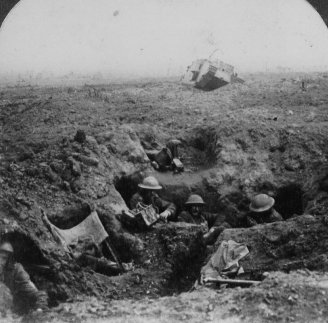Of Forts and Trenches
Today, we reinvent defensive fortifications. The University of Houston's College of Engineering presents this series about the machines that make our civilization run, and the people whose ingenuity created them.
What should forts look like? The great American forts of the 19th century took a form most of us have forgotten. The towers and loopholed overhangs on the old Medieval castles could not stand up to cannon fire. So, by 1800, forts presented a simpler and lower profile -- a long thin line of wall.
Most 19th-century forts were square or pentagonal, with bastions on each corner. Bastions are spade-shaped widenings of the corners. They let defenders fire parallel to the walls. Bastions gave those old forts the shape of great stone snowflakes.
Fort Sumter, out in Charleston Bay, was five-sided, but it sat on the tip of an island. Water came right up to four of its walls. Only the fifth wall needed the protection of bastions.
The Civil War began with the Confederacy pouring 40,000 artillery rounds into Fort Sumter. They killed no one, but the Fort was beginning to crack. So the Union surrendered.
A prophetic siege took place in Europe a year later. At the Battle of Duppel, 6000 ill-equipped Danes built a long fortified trench and held off 18,000 well-equipped Prussians. Instead of crumbling under Prussian artillery fire, the Danes' protective dirt just flew into the air and fell back down. The Prussians won, but it took two months, and it cost far too many lives.
At the same time in America, the Union was rolling a new breed of long-range rifled cannons into place. Those guns could sit outside the range of the old smooth-bore Confederate artillery. They quickly pounded the major Southern forts into gravel.
Then, in 1863, the Union set up on Morris Island in Charleston Bay, outside the range of Fort Sumter's guns. They commenced to hammer Sumter into gravel as well. But the Confederate troops simply shoveled dirt and sand into the holes and burrowed in under it.
In a few days the combination of Federal guns and Confederate ingenuity had turned the fort into the same sort of breastworks that had protected the Danes at Duppel. Period photographs of Sumter show what appears to be total destruction. Yet it was in fact an impenetrable redoubt. Accident had taught the South just as it had the Danes. The North never did take the fort.
And we're left with a remarkable example of how technology informs us. Masonry was no protection against the new rifled cannons, but pulverized walls were. Southern ingenuity was alert to that lesson. By war's end the South had reinvented defensive fortifications. The old masonry forts lingered another half century, but they never again played any important role in war.
I'm John Lienhard, at the University of Houston, where we're interested in the way inventive minds work.
(Theme music)
Robinson, W.B., American Forts: Architectural Form and Function. Urbana, IL: University of Illinois Press. (Published for the Amon Carter Museum of Western Art, Fort Worth, TX), 1977.
See also Episode 108.
I'm grateful to Tom McConn, UH History Department, for his counsel.

From the 1832 Edinburgh Encyclopaedia
A typical early 19th-century pentagonal fortification

Image courtesy of Sims McCutchan
Stereopticon photo of a WW-1 battlefield: No more forts.